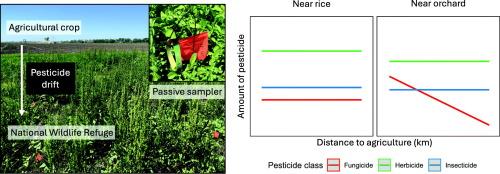在加州萨克拉门托山谷的五个野生动物保护区检测到农药污染
IF 8
1区 环境科学与生态学
Q1 ENVIRONMENTAL SCIENCES
引用次数: 0
摘要
应用生态科学的一个重要目标是了解受保护或受管理土地上的生物多样性受到人为压力的程度。在美国的各种保护土地中,国家野生动物保护区系统的重点是保护和管理本地野生动物和植物种群。保护区可以与湿地联系在一起,特别是在加州,往往靠近人类密集使用的地区,包括农业。由于避难所靠近耕地,可能会受到农药漂移的影响,这增加了对植物和野生动物产生非目标效应的可能性。我们使用被动采样器方法量化了2023年春季28天内加利福尼亚州萨克拉门托山谷五个避难所的空中农药沉积。在研究区域的所有避难所和地块中都检测到杀虫剂,从49块地块的176个硅胶带中鉴定出36种化合物,包括杀虫剂、除草剂和杀菌剂。在我们的模型中,对于大多数污染指数,与农业的距离不是一个重要的预测因子。然而,我们的模型显示,最近的作物类型是距离农业重要性的重要中介,因为只有当果园是最近的作物类型时,杀菌剂污染才会随着距离农业的远近而减少。总体上缺乏距离效应表明,研究区域内避难所的内部不一定比避难所的边缘提供更多的农药保护,尽管较大的避难所可以提供更多的保护。我们目前缺乏关于这里发现的污染水平与野生动物的生物学相关性的信息,并且正在进行的监测工作已经在研究区域发现了多产的昆虫群落。本研究结果为今后在保护区调查分析特定农药化合物对植物和野生动物的影响奠定了基础。本文章由计算机程序翻译,如有差异,请以英文原文为准。

Pesticide contamination detected across five wildlife refuges in the Sacramento Valley of California
An important goal for the applied ecological sciences is to understand the extent to which the biodiversity on conserved or managed lands is exposed to anthropogenic stressors. Among the various categories of conserved lands in the United States, the National Wildlife Refuge System is focused on the protection and management of native wildlife and plant populations. Refuge lands can be associated with wetlands and, especially in California, tend to be near areas of intense human use, including agriculture. The proximity of refuges to cultivated lands results in potential exposure to pesticide drift, which increases the possibility of non-target effects on plants and wildlife. We used a passive sampler approach to quantify aerial pesticide deposition during 28 days in spring of 2023, across five refuges in the Sacramento Valley of California. Pesticides were detected across all refuges and plots within the study area, with 36 individual compounds identified, including insecticides, herbicides, and fungicides, from 176 silicone bands from 49 plots. Distance to agriculture was not an important predictor in our models for most indices of contamination. However, our models revealed that the nearest crop type was an important mediator of the importance of distance to agriculture, as fungicide contamination decreased with distance to agriculture only when orchards were the nearest crop type. The overall lack of distance effects suggests that the interior of refuges in the study area do not necessarily provide more protection from pesticides than refuge edges, although larger refuges could offer more protection. We currently lack information on how the level of contamination found herein is biologically relevant to wildlife, and ongoing monitoring efforts have found productive communities of insects in the study area. The results of this study provide a foundation for future investigations on refuges to analyze impacts of specific pesticide compounds on plants and wildlife.
求助全文
通过发布文献求助,成功后即可免费获取论文全文。
去求助
来源期刊

Science of the Total Environment
环境科学-环境科学
CiteScore
17.60
自引率
10.20%
发文量
8726
审稿时长
2.4 months
期刊介绍:
The Science of the Total Environment is an international journal dedicated to scientific research on the environment and its interaction with humanity. It covers a wide range of disciplines and seeks to publish innovative, hypothesis-driven, and impactful research that explores the entire environment, including the atmosphere, lithosphere, hydrosphere, biosphere, and anthroposphere.
The journal's updated Aims & Scope emphasizes the importance of interdisciplinary environmental research with broad impact. Priority is given to studies that advance fundamental understanding and explore the interconnectedness of multiple environmental spheres. Field studies are preferred, while laboratory experiments must demonstrate significant methodological advancements or mechanistic insights with direct relevance to the environment.
 求助内容:
求助内容: 应助结果提醒方式:
应助结果提醒方式:


